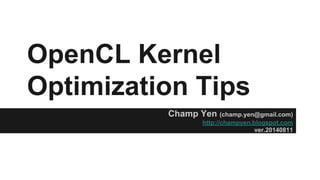OpenCL Kernel Optimization Tips
- 1. OpenCL Kernel Optimization Tips Champ Yen (champ.yen@gmail.com) http://champyen.blogspot.com ver.20140820
- 2. Optimization - a form of balance Device/Platform Features Runtime Toolchain Problem Algorithm Optimization Optimization is not only greedy searching in single direction. It is more like to find a good balance point between device, toolchain and the problem.
- 3. Device - Computation ŌŚÅ device type ŌŚŗ cpu - powerful single thread performance ŌŚŗ gpu - many threads, great total throughput ŌŚÅ ISA design ŌŚŗ scalar-based ŌŚŗ vector-based ŌŚÅ # of compute unit/processing elements ŌŚÅ estimate impact of using divergence & barrier ŌŚÅ capability of asynchronous data transfer
- 4. Device - Memory ŌŚÅ get basic memory characteristics: ŌŚŗ size ŌŚŗ latency ŌŚŗ throughput ŌŚŗ coalescing effect ŌŚŗ addressing mode ŌŚÅ global memory - unified or not ŌŚÅ local memory - real or not ŌŚÅ penalty of oversize
- 5. Toolchain/Runtime ŌŚÅ document/tutorial/guide for debugging, profiling and optimization. ŌŚÅ there is no perfect runtime/toolchain ŌŚÅ profiling/debugging tools. ŌŚÅ it is not always a good idea to debug/optimization on different platforms. ŌŚÅ automatic optimization MAY NOT HELP the thinking of optimization ŌŚÅ tricky forms of computation/memory operations. ŌŚŗ MAD operations ŌŚŗ memory access mode
- 6. Problem/Algorithms ŌŚÅ DATA PARALLEL! ŌŚÅ multi-stages is not always bad. ŌŚŗ doing all things together uses more memory resource in one workitem. ŌŚÅ vectorized is not always a good idea ŌŚÅ use appropriate work group size ŌŚŗ bad memory access pattern, less coalescing ŌŚŗ may cause lower cache hit rate ŌŚŗ less local memory for each workitem ŌŚŗ may be less private memory for each workitem. ŌŚÅ different form of implementation ŌŚÅ do optimization things manually. ŌŚŗ DO NOT relies on automatic features.
- 7. Q & A







